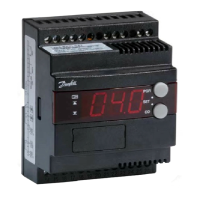8 Manual RS8AX702 DKRCC.ES.R1.A1.02/ 520H4020 © Danfoss 01-2011 EKC 347
Operation Menu survey
The buttons
When you want to change a setting, the two buttons will give you
a higher or lower value depending on the button you are push-
ing. But before you change the value, you must have access to the
menu. You obtain this by pushing the upper button for a couple
of seconds - you will then enter the column with parameter codes.
Find the parameter code you want to change and push the two
buttons simultaneously. When you have changed the value, save
the new value by once more pushing the two buttons simultane-
ously.
Gives access to the menu
(or cutout an alarm)
Gives access to changes
Saves a change
Examples of operations
Set reference
1. Push the two buttons simultaneously
2. Push one of the buttons and select the new value
3. Push both buttons again to conclude the setting
Set one of the other menus
1. Push the upper button until a parameter is shown
2. Push one of the buttons and nd the parameter you want to
change
3. Push both buttons simultaneously until the parameter value is
shown
4. Push one of the buttons and select the new value
5. Push both buttons again to conclude the setting
SW = 1.1x
Literature survey:
Manual for EKC 347 ..............................................................RS8AX---
Instruction for EKC 347 .......................................................RI8BY---
Installation guide, "Data communication link
for ADAP-KOOL® " .................................................................RC8AC---
Display
The values will be shown with three digits, and after an opera-
tion the controller will return to its standard mode and show the
measured liquid level.
Light-emitting diodes (LED) on front panel
There are LED’s on the front panel which will light up when the
corresponding relay is activated.
The upper LED will indicate the valve’s opening degree. A short
pulse indicates a slow liquid ow and a long pulse a fast liquid
flow.
The three lowest LED’s will ash, if there is an error in the regula-
tion.
In this situation you can upload the error code on the display and
cancel the alarm by giving the uppermost button a brief push.
Function
Pa-
ram-
eter
Min. Max.
Fac.
set-
ting
Normal display
Read the measured liquid level - % 50.0
If you wish to see the actual opening degree, give the
lower button a brief push
- % 0
If you wish to set the required setpoint you obtain ac-
cess by pushing both buttons simultaneously
- 0% 100% 100
Level control
External contribution to the reference. Cf. also o10.
Value is set in %-points.
r06 -100 100 0.0
Start / stop of level control r12 OFF/0 ON/1 1
Alarm
Upper level limit A01 0 % 100% 85
Lower level limit A02 0% 100% 15
Time delay for upper level limit A03 0 s 999 s 50
Time delay for lower level limit A15 0 s 999 s 10
Level alarm limit A16 0 % 100 % 20
Delay for level alarm A17 0 s 999 s 0
The level alarm is linked to:
0: Rising level (higher level than A16)
1: Falling level (lower level than A16)
2: Same function as if A18=0. When A2 alarm is gener-
ated and Relay for lower level limit, gives OFF signal
(cut out).
3: Same function as if A18=1 When A2 alarm is gener-
ated and Relay for lower level limit, gives OFF signal
(cut out).
A18 0 3 0
Function for Alarm relay when A1, A2 or A3 alarms are
detected.
0: Alarm relay to be activated when A1 or A2 or A3 are
detected.
1: Alarm relay only to be activated when A3 is detected.
A19 0 1 0
Regulating parameters
P - band n04 0%/O 200% 30
I: Integration time Tn n05 60
600/
O
400
Period time (only if AKV/A valve is used) n13 3 s 10 s 6
Max. opening degree n32 0% 100% 100
Min. opening degree n33 0% 100% 0
Neutral zone (only for ICM valve) n34 2% 25% 2
Denition of regulating principle
Low: On the low-pressure side (valve closes when
liquid level is rising)
High: On the high-pressure side (valve opens when
liquid level is rising)
n35 Low/0 Hig/1 0
Miscellaneous
Controller's address o03* 0 60 0
ON/OFF switch (service-pin message) o04* OFF ON
Dene valve and output signal:
1: ICM. AO: 4-20 mA
2: ICM. AO: 0-20 mA
3: AKV/A, AO: 4-20 mA
4: AKV/A, AO: 0-20 mA
Or if a master/slave function is used:
5: AKV/A, MASTER
6: AKV/A, SLAVE 1/1. AO:4-20 mA
7: AKV/A, SLAVE 1/1. AO:0-20 mA
8: AKV/A, SLAVE 1/2. AO:4-20 mA
9: AKV/A, SLAVE 1/2. AO:0-20 mA
10: AKV/A, SLAVE 2/2. AO:4-20 mA
11: AKV/A, SLAVE 2/2. AO:0-20 mA
12: AKV/A, SLAVE 1/1. AO:4-20 mA - AO always updated
13: AKV/A, SLAVE 1/1. AO:0-20 mA- AO always updated
14: AKV/A, SLAVE 1/2. AO:4-20 mA- AO always updated
15: AKV/A, SLAVE 1/2. AO:0-20 mA- AO always updated
16: AKV/A, SLAVE 2/2. AO:4-20 mA- AO always updated
17: AKV/A, SLAVE 2/2. AO:0-20 mA- AO always updated
o09 1 17 1

